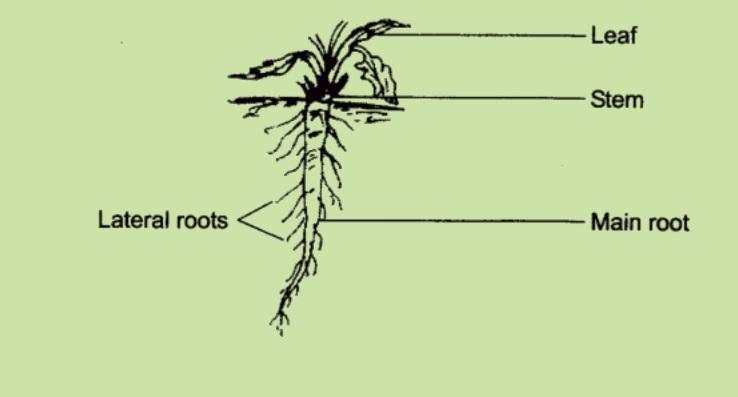Class 6 Science Chapter 7 Getting to know Plants answer to each chapter is provided in the list so that you can easily browse throughout different chapter Assam Board As Per New Syllabus Class 6th Science Unit Class 6 Science Chapter 7 Getting to know Plants and select needs one.
SEBA Class 6 Science Chapter 7 Getting to know Plants
Also, you can read the SCERT book online in these sections Solutions by Expert Teachers as per SCERT (CBSE) Book guidelines. These solutions are part of SCERT All Subject Solutions. Here we have given Assam Class 6 Science Solutions for All Subject, You can practice these here.
Getting to know Plants
Chapter: 7
| Exercise |
1. Correct the following statements and rewrite them in your notebook.
(a) Steam absorbs water and minerals from the soll.
(b) Leaves hold the plant upright.
(c) Roots conduct water to the leaves.
(d) The number of petals and sepals in a flower in always equal.
(e) If the sepals of a flower are joined together, it’s petals also joined together.
(f) If the petals of a flower are joined together, then the pistil is joined to the petal
Ans: (a) Roots absorb water and minerals from the soil.
(b) Roots hold the plant upright.
(c ) Stem conducts water to the leaves.
(d) The number of petals and sepals in a flower is usually equal.
(e) If the sepals of a flower are joined together, its petals are not necessarily joined together.
(f) If the petals of a flower are joined together, then the pistil is not joined to the petal.
2. Draw
(a) a leaf.
(b) a taproot. and
(c) a flower, you have studied for table 7.3.
Ans: (a) leaf:

(b) a taproot:

(c ) a flower:

3. Can you find a plant in your house or in your neighborhood, which has a long but weak stem? Write its name. In which category would you classify it?
Ans: Yes, we found a bottle gourd (lauki) plant in our house. It is a climber.
4. What is the function of a stem in a plant?
Ans: Following are the function of a stem in a plant:
- Stem holds the plant upright.
- Stems transport water from roots to different parts of plants.
- Stems conduct food from leaves to other parts of the plants.
5. Which of the following leaves have reticulate venation?
Wheat, Tulsi, maize, grass, coriander (dhaniya), china rose
Ans: Tulsi, coriander and China rose.
6. If a plant has fibrous root, what type of venation do its leaves likely to have?
Ans: If a plant has a fibrous root, its leaves have parallel venation.
7. If a plant has leaves with reticulate venation, what kind of roots will it have?
Ans: If a plant has leaves with reticulate venation, it will have a tap root.
8. Is it possible for you to find out whether a plant has taproot or fibrous roots by looking at the impression of its leaf on a sheet of paper?
Ans: Yes it is possible to find out whether a plant has taproot or fibrous roots by looking at the impression of its leaf on a sheet of paper.
9. Write the names of the parts of a flower.
Ans: Sepal, petal, stamens, pistil.
10. Which of the following plants have you see? Of those that you have seen. which sne have flowers?
Grass, maize, wheat, chili, tomato, Tulsi, pipal, shisham, banyan, mango, Jamun, guave, pomegranate, papaya, banana, lemon, sugarcane, potato, groundnut.
Ans: Plants which have flowers are: Grass, maize, wheat, chili, tomato, Tulsi, pipal, shisham, banyan, mango, Jamun, guave, pomegranate, papaya, banana, lemon, sugarcane, potato, groundnut.
11. Name the part of the plant which produces its food. Name this process.
Ans: Leaves produce food for plants. The name of this process is photosynthesis.
12. In which part of a flower, you are likely to rid the ovary?
Ans: We are likely to rid the ovary of the lowermost part of the pistil.
13. Name two flowers, each with joined and separated sepals.
Ans: Flowers with joined sepals:
(i) Datura.
(ii) Cotton.
Flowers with separate sepals:
(i) Rose.
(ii) Mustard.

Hi, I’m Dev Kirtonia, Founder & CEO of Dev Library. A website that provides all SCERT, NCERT 3 to 12, and BA, B.com, B.Sc, and Computer Science with Post Graduate Notes & Suggestions, Novel, eBooks, Biography, Quotes, Study Materials, and more.




Short ke dibo na all sub answer bur main ke science and social science plz plz plz